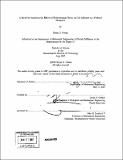A model for analyzing the effects of hydrodynamic forces on cell adhesion in a perfused bioreactor
Author(s)
Owens, Bryan D
DownloadFull printable version (2.308Mb)
Other Contributors
Massachusetts Institute of Technology. Dept. of Mechanical Engineering.
Advisor
Linda G. Griffith.
Terms of use
Metadata
Show full item recordAbstract
In bioreactor culture systems that aim to provide a convective flux to address mass transport limitations of oxygen and other nutrients, large hydrodynamic forces and shear stress can potentially serve as a negative signals in tissue formation and morphogenesis. Shear stress and hydrodynamic forces may inhibit the formation of tissue from single cells by disrupting the integrin-mediated bonds with the extracellular matrix or the cadherin-mediated bonds with neighboring cells. In order to explore the relationship between the imposed forces and stresses from fluid flow and the inherent biological forces involved in cell adhesion, this thesis presents a simple model of cells in a planar array subject to perfused flow. The modeling and sensitivity analysis of the system are covered within this thesis. Two models were built using first principles, and a range of physiological parameter values were used to estimate the forces and stresses generated by the perfusion flow. A third dynamical model from the literature was also employed. A computational approach using finite element modeling was also employed as a further tool for analysis. The resulting analyses yield valuable models that can model a range of cellular arrangements expected in a perfused bioreactor arrangement as a means to magnify and highlight the behavior at the microscale.
Description
Thesis (S.B.)--Massachusetts Institute of Technology, Dept. of Mechanical Engineering, 2007. Includes bibliographical references (p. 61-63).
Date issued
2007Department
Massachusetts Institute of Technology. Department of Mechanical EngineeringPublisher
Massachusetts Institute of Technology
Keywords
Mechanical Engineering.